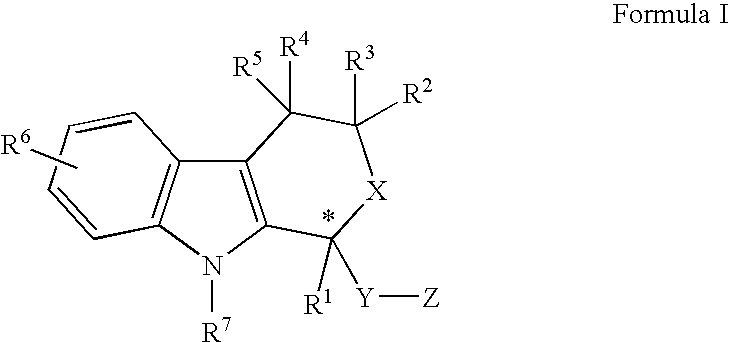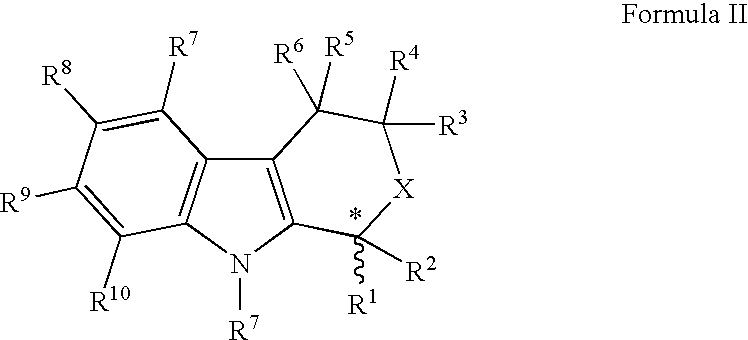Direct racemization of indole derivatives
a technology of indole derivatives and derivatives, applied in the field of direct racemization of indole derivatives, can solve the problems of form not being used, ending up being discarded, etc., and achieve the effect of reducing pressur
- Summary
- Abstract
- Description
- Claims
- Application Information
AI Technical Summary
Benefits of technology
Problems solved by technology
Method used
Image
Examples
example 1
Effect of Temperature
[0048] In the preparation of pure (S)-etodolac via esterfication of (S)-etodolac and basic hydrolysis, significant decomposition of (S)-etodolac was observed when (S)-etodolac was refluxed in methanol. Also, faster degradation of etodolac with increasing temperature, in aqueous solution, has been reported (Lee et al., Pharm. Sci. (1988), 77, 81). Thus, varied reaction temperatures were examined for racemization of (S)-etodolac by using concentrated H2SO4 in 1,4-dioxane. The results, as summarized in Table 1, suggested that increasing temperature enhances the racemization, but higher temperature, in particular, over 50° C. gave rise to significant decomposition of (S)-etodolac.
TABLE 1Effect of Temperature on Racemization of (S)-Etodolacaresultstemperaturepercentage ofentry(° C.)ratio of R:S of Etodolacside products (%)b1200.23:1.0102500.40:1.0133100—cmajor
aracemization reaction conditions unless otherwise indicated: 0.37 mmol of (S)-etodolac and one equivalent...
example 2
Effect of Solvent on Racemization of (S)-Etodolac
[0049] A variety of readily available organic solvents were examined for solvent effect. The data given in Table 2 indicate that 2-propanol is a good solvent, in which the racemization reaction is completed at room temperature along with the formation of a very small amount of side products.
TABLE 2Effect of Solvent on Racemization of (S)-etodolacaresultspercentage ofentrysolventratio of R:S of Etodolacside products (%)b1MeOH—c—c2CH3CN0.10:1.0 8731,4-dioxane0.22:1.0 114THFno racemation—52-propanol1:1 5
aracemization reaction conditions unless otherwise indicated: 20° C., 0.37 mmol of (S)-etodolac, and 1.5 equivalent of acid in 5-10 ml of organic solvent. For HPLC analysis, a portion of reaction mixture was taken out after about 16-18 hours and concentrated under reduced pressure. The residue was extracted from water with dichloromethane twice. The combined organic phases were dried over MgSO4, filtered, and concentrated.
# The result...
example 3
Effects of Brønsted Acids and Lewis Acids
[0050] In order to study the effects of both Brønsted acid and Lewis acid on recemization of (S)-etodolac, concentrated H2SO4, HCl (as a gas solution in 1,4-dioxane), BF3-Et2O, SOCl2, SnCl4, TiCl4, AlCl3, and Lanthanum triflate were examined for racemization reaction of (S)-etodolac in 2-propanol. The experimental results as shown in Table 3 indicate that BF3-Et2O and H2SO4 are good acids for the racemization reaction.
TABLE 3Effects of Brønsted acid and Lewis acid onRacemization of (S)-Etodolacaconditionsresultsreactionratio of R:S ofpercentage ofentryacidtimeEtodolacside products (%)b1SOCl218 hless than 0.06:1.0cless than 4c2SnCl418 h0.39:1.0 nod3TiCl418 hless than 0.06:1.0cless than 4c4AlCl324 hless than 0.37:1.0cless than 27c5La(CF3SO3)324 hless than 0.01:1.0cnod6HCl21 h0.30:1.0 37BF3-Et2O15 h1:16%8H2SO4 4 h1:12
aRacemization reaction conditions unless otherwise indicated: 20° C., 0.37 mmol of (S)-etodolac, and 1-1.5 equivalents of acid ...
PUM
| Property | Measurement | Unit |
|---|---|---|
| temperature | aaaaa | aaaaa |
| time | aaaaa | aaaaa |
| temperature | aaaaa | aaaaa |
Abstract
Description
Claims
Application Information
 Login to View More
Login to View More - R&D
- Intellectual Property
- Life Sciences
- Materials
- Tech Scout
- Unparalleled Data Quality
- Higher Quality Content
- 60% Fewer Hallucinations
Browse by: Latest US Patents, China's latest patents, Technical Efficacy Thesaurus, Application Domain, Technology Topic, Popular Technical Reports.
© 2025 PatSnap. All rights reserved.Legal|Privacy policy|Modern Slavery Act Transparency Statement|Sitemap|About US| Contact US: help@patsnap.com



